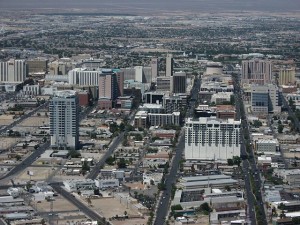This week’s Start-Up City: Miami conference, hosted by Atlantic Cities and the Knight Foundation and held at New World Center on Miami Beach, drew hundreds of South Florida’s brightest thinkers. They came to share ideas about how to kindle Miami’s startup culture and listen to entrepreneurial luminaries recount their own experiences. Zappos CEO Tony Hsieh, Zipcar founder Robin Chase and AOL patriarch Steve Case were among those who took part.
The list of noteworthy discussion topics is long, but Tony Hsieh’s presentation on his work to revitalize downtown Las Vegas struck a chord with me.
 On any given day, Hsieh’s morning cup of coffee may be interrupted by complete strangers.
On any given day, Hsieh’s morning cup of coffee may be interrupted by complete strangers.
Hsieh is undertaking a social experiment. Faced with the prospect of relocating Zappos to a new office in Las Vegas or uprooting the entire company (and its 2,000 employees) to Silicon Valley, he decided to stay put.
He scoured the city for office space, but nothing seemed quite right.
When the City of Las Vegas announced it was vacating its building in favor of a new facility across town, Hsieh pounced on the opportunity to buy City Hall.
The renovation was projected to take two years. Zappos visited corporate offices around the world to gather the best ideas in office design. Hsieh toured the headquarters of Google, Apple, Nike, you name it – all in search of ideas worth imitating.
But there was still a major problem.
The area north of downtown Las Vegas where City Hall was located was awash with empty parking lots, condemned buildings, and unfinished condo projects that had succumbed to the recession. This was a far cry from the glitz and glam of the Strip, just three miles away.
Hsieh worried that a sea of blight outside his company’s front doors would dampen employee morale and take a toll on a corporate culture built around the concept of happy customers and happy employees.
Then he hatched a big idea (this is what billionaire entrepreneurs do, it seems).
 Recognizing that establishing a strong sense of community inside his new workplace meant creating a strong sense of community outside, Hsieh got to work. He pledged $350 million of his personal wealth to developing a neighborhood from the ground up.
Recognizing that establishing a strong sense of community inside his new workplace meant creating a strong sense of community outside, Hsieh got to work. He pledged $350 million of his personal wealth to developing a neighborhood from the ground up.
$100 million is being spent on property acquisitions, renovations and new construction. Another $100 million will develop apartments that cater to Zappos employees and their Creative Class peers. $50 million will fund technology startups that Hsieh hopes to lure by offering seed money. $50 million has been invested in small businesses ranging from coffee shops and bars, to a yoga studio and a bookstore. The last $50 million is going toward education, with an early childhood education center and charter school in the works.
There’s more. Hsieh is building a small theater that will host a daily speakers series. A public park built out of recycled materials and old shipping contained will provide kids with a safe place to play.
In an effort to populate the area with residents and visitors, Hsieh has purchased and furnished 60 distressed condos in the nearby building that he calls home. The units are available gratis to friends and family of Zappos employees, as well as “creative entrepreneurs” passing through Las Vegas (Everyone in attendance at the Miami Beach conference was invited; I’ve already booked a flight to Vegas. Just kidding.).
Hsieh’s $350 million investment is a text book example of someone identifying a problem, dreaming up a solution, and figuring out a way to realize that vision. His investments in downtown Las Vegas happens to be consistent with Zappos’ corporate culture built on customer and employee satisfaction. Sure, they sell shoes and they do it well, but think about how hard it must have been to convince people to buy shoes over the Internet for the very first time.
If Zappos were only selling shoes, they wouldn’t stand a chance competing against the Foot Lockers of the world. But they are selling a culture of content that originates with the founder and carries through the staff all the way to the person who answers the phone when you call customer service.
While time will tell whether Hsieh’s social experiment pays off, one thing is for sure. Zappos’ strong company culture is likely to have a positive impact on the community outside.







 See More Blogs
See More Blogs
Comments